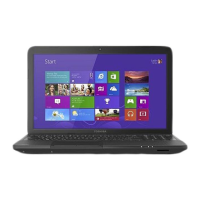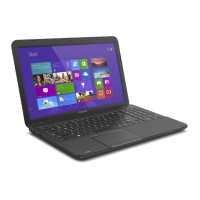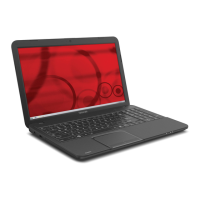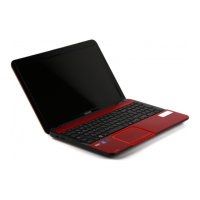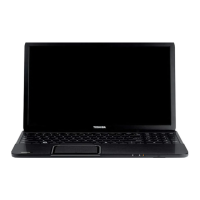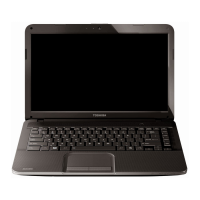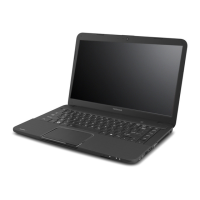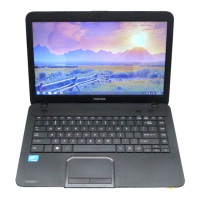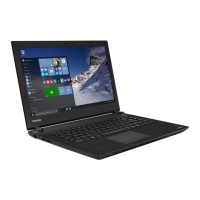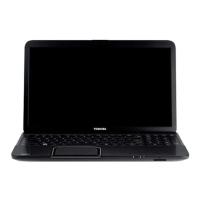
Do you have a question about the Toshiba C850 and is the answer not in the manual?
| RAM | Up to 8 GB DDR3 |
|---|---|
| Battery | 6-cell Lithium-ion |
| Wireless | Wi-Fi 802.11 b/g/n |
| Webcam | Integrated HD Webcam |
| Storage | 500GB/750GB/1TB HDD |
| Display | 15.6-inch HD (1366x768) |
| Graphics | Intel HD Graphics or AMD Radeon HD |
| Operating System | Windows 7/8 |
| Optical Drive | DVD SuperMulti |
| LAN | 10/100 Ethernet |
| Ports | USB 2.0/3.0, HDMI, VGA, headphone/microphone combo jack |
| Processor | Intel or AMD (various models) |
Introduction to the manual's purpose and content.
Important safety and operational guidelines for computer use.
List of items to check for upon receiving the computer.
Identifies external components visible when the display is closed.
Details ports and features on the computer's left side.
Details ports and features on the computer's right side.
Identifies components located on the rear of the computer.
Shows components and features on the bottom of the computer.
Identifies external components visible when the display is open.
Describes the computer's internal hardware elements.
Explains how to use the computer's touchpad for navigation.
Covers keyboard layout, indicators, and special keys.
Details the functionality and types of optical drives.
Information on playing DVD-Video content using the Toshiba player.
Details on using the Toshiba Blu-ray Disc player software.
Instructions for playing 3D content on external devices.
Overview of wireless features like Wi-Fi and Bluetooth.
Information on connecting to a Local Area Network.
Details on connecting external devices like memory cards.
How to connect and use an external display.
Instructions for connecting devices via HDMI.
How to use the security lock slot to prevent theft.
Lists available optional accessories for the computer.
Covers audio settings and features like Volume Mixer.
Explains video mode settings and display adjustments.
Overview of pre-installed software utilities.
Unique or advanced features for enhanced computer use.
Details on managing power saving modes and Sleep/Charge.
Information on setting user and supervisor passwords.
How to configure computer hardware settings via BIOS.
Utility for monitoring system health and performance.
Procedures for restoring the system to its original state.
Explains battery status indicators and power states.
How to interpret the DC IN/Battery and Power indicators.
Information on battery types, care, and charging.
Describes different modes like Shut Down, Hibernation, and Sleep.
Setting automatic power on/off when opening/closing the display.
Automatic system shutdown based on inactivity.
Guidelines for diagnosing and resolving computer issues.
Basic checks to resolve common computer problems.
Tips for identifying the root cause of computer malfunctions.
A comprehensive checklist for hardware-related issues.
Troubleshooting power-related problems.
Resolving issues related to the computer's battery.
Troubleshooting issues with the system's date and time.
Solutions for keyboard malfunctions or unresponsiveness.
Steps to resolve display issues on the laptop screen.
Troubleshooting problems related to the computer's storage drive.
Resolving issues with CD/DVD/Blu-ray drives.
Troubleshooting errors with memory cards.
Resolving issues with the touchpad or mouse.
Solutions for touchpad not working or incorrect sensitivity.
Troubleshooting common problems with USB mice.
Resolving issues with connected USB devices.
Troubleshooting the Sleep and Charge USB feature.
Resolving issues related to audio playback or input.
Troubleshooting problems with external display connections.
Resolving issues with Local Area Network connectivity.
Troubleshooting problems with Wi-Fi connections.
Resolving issues with Bluetooth device connectivity.
Technical details on the computer's physical size and weight.
Operating and non-operating environmental conditions.
Electrical specifications for the AC adapter and computer.
Specification for the power cord's wire gauge.
Specification for the power cord's current capacity.
Lists safety and regulatory certification bodies for power cords.
Explains that not all icons may apply to every model configuration.
Legal footnotes regarding Central Processing Unit performance and conditions.
Legal information related to 64-bit hardware and software requirements.
Legal notes on system memory usage and limitations.
Legal footnotes concerning battery performance and life.
Standards and certifications for Wireless LAN compatibility.
Standards and certifications for Bluetooth compatibility.
Warnings regarding potential interference and performance issues with wireless devices.
